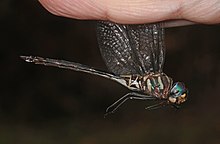Somatochlora margarita, the Texas emerald, is a species of dragonfly in the family Corduliidae. It is endemic to the United States. Its natural habitat is rivers.
| Somatochlora margarita | |
|---|---|

| |
| Scientific classification | |
| Domain: | Eukaryota |
| Kingdom: | Animalia |
| Phylum: | Arthropoda |
| Class: | Insecta |
| Order: | Odonata |
| Infraorder: | Anisoptera |
| Family: | Corduliidae |
| Genus: | Somatochlora |
| Species: | S. margarita
|
| Binomial name | |
| Somatochlora margarita Donnelly, 1962
| |
Description
editThe dimensions of the Texas emerald are 50–54 mm (2.0–2.1 in) in length, 32–41 mm (1.3–1.6 in) abdomen length, and 32–37 mm (1.3–1.5 in) in hindwing length.[2]
Range
editSomatochlora margarita is native to the two U.S. states of Texas and Louisiana. It is known to inhabit just 12 combined eastern Texas counties and western and central Louisiana parishes. The current known range is northwest of Houston and extends east into central Louisiana, reaching as far as Alexandria, Louisiana. The Texas emerald is rarely seen by humans because of its tendency of flying up and perching in and or on the canopy in trees or forests.[3]
References
edit- ^ Abbott, J.C.; Paulson, D.R. (2020). "Somatochlora margarita". IUCN Red List of Threatened Species. 2020: e.T20344A177159374. doi:10.2305/IUCN.UK.2020-3.RLTS.T20344A177159374.en. Retrieved 15 November 2021.
- ^ "OdonataCentral". Archived from the original on 2018-01-27. Retrieved 2018-01-27.
- ^ Hutchins, Benjamin (2016-02-09). "Texas' Rarest Dragonflies Tied to Rare Natural Community, Pitcher-Plant Bogs". Frontiers in Texas Biodiversity. Retrieved 2024-08-30.
Further reading
edit- Bried, Jason T.; Mazzacano, Celeste A. (2010). "National review of state wildlife action plans for Odonata species of greatest conservation need". Insect Conservation and Diversity. 3 (2): 61–71. doi:10.1111/j.1752-4598.2010.00081.x. ISSN 1752-458X. S2CID 85341262.
- Abbott, John C.; Mynhardt, Glené (2007). "Description of the larva of Somatochlora margarita (Odonata: Corduiiidae)". International Journal of Odonatology. 10 (2): 129–136. doi:10.1080/13887890.2007.9748295. ISSN 1388-7890. S2CID 83553786.
